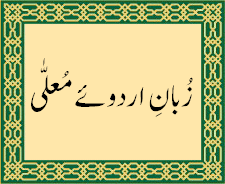اہلِ زبانِ اردو | |
|---|---|
 The phrase Zuban-e-Urdu-e-Mualla or "Language of the Exalted Camp" | |
| Total population | |
| 68.62 million[1] (2019) | |
| Regions with significant populations | |
| India (diasporic Urdu Belt, a regional belt that consists of Hindi-Urdu belt states, many speakers live in various cities in Deccan Plateau) Pakistan (Muhajirs in Karachi, Hyderabad & mainly across large cities in Sindh and other large Pakistani cities) | |
| 50,772,631 (2011)[2] | |
| 14,706,159 - 30,000,000 (2017 census & 2013)[3][4][5][a] | |
| 413,785 (2021)[6] | |
| 397,502 (2013)[7] | |
| 300,000 (2008)[8] | |
| 270,000 (2011)[9] | |
| 210,815 (2016)[10] | |
| 69,131 (2016)[11] | |
| Languages | |
| Urdu | |
| Religion | |
| Islam, small minority Christianity and Judaism | |
Native speakers of Urdu are spread across South Asia.[note 1][13][14] The vast majority of them are Muslims of the Hindi–Urdu Belt of northern India,[note 2][15][16][17] followed by the Deccani people of the Deccan plateau in south-central India (who speak Deccani Urdu), most of the Muhajir people of Pakistan, Muslims in the Terai of Nepal, and Muslims of Old Dhaka in Bangladesh.[18][5] The historical centres of Urdu speakers include Delhi and Lucknow.[19][20] Another defunct variety of the language was historically spoken in Lahore for centuries before the name "Urdu" first began to appear. However, little is known about this defunct Lahori variety as it has not been spoken for centuries.[21]
The term "Urdu-speakers" does not encompass culturally non-native speakers who may use Urdu as a first or second language, which would additionally account for a much larger number of total speakers in South Asia.[12]
- ^ Urdu at Ethnologue (22nd ed., 2019)

- ^ "Census of India 2011: Language" (PDF). Office of the Registrar General and Census Commissioner of India. 2011. Retrieved 28 May 2020.
- ^ "POPULATION BY MOTHER TONGUE, SEX AND RURAL/ URBAN" (PDF). pbs.gov.pk. Pakistan Bureau of Statistics. 2017. Retrieved 2023-03-14.
- ^ Hasnain, Khalid (2021-05-19). "Pakistan's population is 207.68m, shows 2017 census result". Dawn. Archived from the original on 2022-10-17. Retrieved 2022-11-12.
- ^ a b Carl Skutsch (7 November 2013). Encyclopedia of the World's Minorities. Taylor & Francis. pp. 2234–. ISBN 978-1-135-19395-9.
- ^ National Statistics Office (2021). National Population and Housing Census 2021, Caste/Ethnicity Report. Government of Nepal (Report).
- ^ "Detailed Languages Spoken at Home and Ability to Speak English for the Population 5 Years and Over for United States: 2009-2013".
- ^ "Citizenship for Bihari refugees". BBC News. 19 May 2008. Retrieved 19 July 2020.
- ^ "2011 Census: Quick Statistics". Office for National Statistics. Retrieved 11 April 2015.
- ^ "Census Profile, 2016 Census, Canada". Government of Canada, Statistics Canada. 8 February 2017. Retrieved 6 October 2020.
- ^ Cite error: The named reference
SBSwas invoked but never defined (see the help page). - ^ a b Čedomir Nestorović (28 May 2016). Islamic Marketing: Understanding the Socio-Economic, Cultural, and Politico-Legal Environment. Springer. pp. 142–. ISBN 978-3-319-32754-9.
- ^ Joseph, Ammu (2004). Just Between Us: Women Speak about Their Writing. Women's World, India. ISBN 978-81-88965-15-1.
- ^ Mir, Raza (2014-06-15). The Taste of Words: An Introduction to Urdu Poetry. Penguin UK. ISBN 978-93-5118-725-7.
- ^ Roy, Arundhati (1 September 2020). Azadi: Freedom. Fascism. Fiction. Haymarket Books. ISBN 978-1-64259-380-8.
The language known variously as Urdu/Hindi/Hindustani, and in an earlier era, Hindavi, was born on the streets and in the bazaars of North India. Khari Boli, spoken in and around Delhi and what is now western Uttar Pradesh, is the base language of which the Persian lexicon came to be added. Urdu, written in the Persian-Arabic script, was spoken by Hindus and Muslims across North India and the Deccan Plateau. ... The partitioning orf Urdu began in earnest in the second half of the nineteenth century, after the failed 1857 Ware of Independence (known to the British as the Mutiny), when India ceased to be merely an asset of the East India Company.
- ^ Ginsburgh, V.; Weber, S. (8 April 2016). The Palgrave Handbook of Economics and Language. Springer. ISBN 978-1-137-32505-1.
Urdu is a stylized version of the colloquial language spoken by both Muslims and Hindus in what is now central north India.
- ^ Farooqi, M. (2012). Urdu Literary Culture: Vernacular Modernity in the Writing of Muhammad Hasan Askari. Springer. ISBN 978-1-137-02692-7.
Historically speaking, Urdu grew out of interaction between Hindus and Muslims. He noted that Urdu is not the language of Muslims alone, although Muslims may have played a larger role in making it a literary language. Hindu poets and writers could and did bring specifically Hindu cultural elements into Urdu and these were accepted.
- ^ Cite error: The named reference
AlexanderChatterji2015was invoked but never defined (see the help page). - ^ Schmidt, Ruth Laila (8 December 2005). Urdu: An Essential Grammar. Routledge. ISBN 978-1-134-71319-6.
Historically, Urdu developed from the sub-regional language of the Delhi area, which became a literary language in the eighteenth century. Two quite similar standard forms of the language developed in Delhi, and in Lucknow in modern Uttar Pradesh. Since 1947, a third form, Karachi standard Urdu, has evolved.
- ^ Mahapatra, B. P. (1989). Constitutional languages. Presses Université Laval. p. 553. ISBN 978-2-7637-7186-1.
Modern Urdu is a fairly homogenous language. An older southern form, Deccani Urdu, is now obsolete. Two varieties however, must be mentioned viz. The Urdu of Delhi, and the Urdu of Lucknow. Both are almost identical, differing only in some minor points. Both of these varieties are considered 'Standard Urdu' with some minor divergences.
- ^ Brian Spooner; William L. Hanaway, eds. (19 March 2012). Literacy in the Persian World: Writing and Social Order. University of Pennsylvania Press, 2012. p. 296. ISBN 978-1934536568.
Cite error: There are <ref group=note> tags on this page, but the references will not show without a {{reflist|group=note}} template (see the help page).